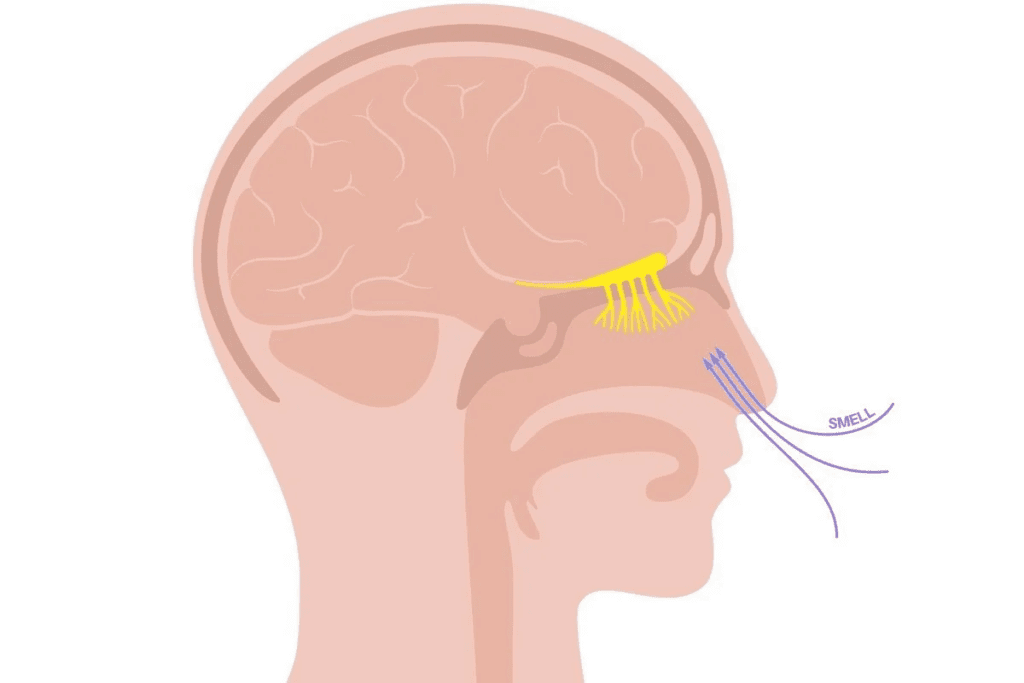Last Updated on November 27, 2025 by Ugurkan Demir

Deviated nasal septum symptoms: Learn how the condition can block drainage, leading to an increased risk of chronic sinus infections.
Many people struggle with nasal blockage and frequent sinus infections. These problems can really affect their daily life. A deviated septum, or a crooked nasal wall, is often the root cause. It can mess up airflow and mucus flow, making it easy for sinus infections to stick around.
Studies show that about 75% of people have a deviated nasal septum. And about 47.5% of those with nasal problems also have sinusitis. It’s key to understand how nasal issues can affect sinus health. We’ll look into how a deviated septum can lead to sinus problems and why treating it is so important.

The nasal septum is a wall made of cartilage and bone. It divides the nasal passages and is key for breathing and sinus drainage. It’s a vital part of our nasal anatomy, playing a big role in our respiratory health.
The nasal septum is made of cartilage and bone, splitting the nasal cavity into two nostrils. It’s covered by a mucous membrane that warms, humidifies, and filters the air we breathe. A healthy nasal septum is essential for unobstructed airflow through the nasal passages.
The nasal septum is usually straight, making both nasal passages roughly equal in size. This balance ensures smooth airflow and proper sinus drainage. The nasal septum also supports the nasal passages during breathing, helping to prevent nasal obstruction and related breathing difficulties.
The nasal septum is vital for healthy airflow and sinus drainage. When it’s straight and working right, it lets air flow freely through the nasal passages. It also helps mucus drain from the sinuses properly. This prevents mucus buildup, reducing sinus infection risk. A deviated septum can block airflow, cause stuffiness, and increase sinusitis risk.
Understanding the nasal septum’s normal function is key to seeing how a deviated septum affects our health. Recognizing signs like nasal obstruction and stuffiness helps people get medical care. This can ease symptoms and prevent further problems.

A deviated septum happens when the thin wall between the nasal passages shifts. This shift can block airflow and make it hard to breathe. It also affects how the sinuses drain and how the nose works.
Many people have a deviated septum. About 75% of people have some degree of septal deviation. But not everyone shows symptoms.
Both genetics and injuries can cause a deviated septum. Knowing why and how much it’s deviated helps doctors choose the right treatment.
There are two types of deviated septums. Congenital ones are present at birth, often due to fetal development issues. Acquired ones happen after birth, usually from a nose injury.
Deviated septums can vary in severity. Doctors use classification systems to understand how much the septum is deviated. This helps them see how it affects breathing.
Severity Level | Description | Symptoms |
Mild | Minimal deviation with slight impact on airflow | Occasional nasal congestion |
Moderate | Noticeable deviation affecting airflow | Frequent nasal congestion, occasional sinus pressure |
Severe | Significant deviation causing substantial airflow obstruction | Chronic nasal congestion, frequent sinus infections, and facial pain |
Knowing the common symptoms of a deviated septum can help you know when to see a doctor. A deviated septum can cause many problems, affecting your nose and overall health.
Nasal obstruction is a common symptom of a deviated septum. It can make breathing hard, leading to breathing difficulties. The uneven nasal passage can block airflow, making it hard to breathe through your nose, even when you’re not sick.
Many people with a deviated septum experience facial pain and pressure. The abnormal airflow and pressure can cause sinus pain and facial discomfort. This pain can get worse if not treated.
Nosebleeds are common in those with a deviated septum. The dry and cracked nasal passages can lead to frequent nosebleeds. Also, the mucus drainage can cause postnasal drip, feeling like mucus is running down your throat.
A deviated septum can also disrupt sleep and cause snoring. The blocked nasal passages may make you breathe through your mouth, affecting your sleep. This can also lead to turbulent breathing, causing snoring and sometimes sleep apnea.
It’s important to recognize these symptoms to get the right treatment. If you’re experiencing any of these, seeing a healthcare professional is key for proper care.
Sinusitis, or sinus infection, is when the sinuses get inflamed. This can cause a lot of discomfort. If not treated, it can lead to serious problems.
Sinusitis can be either acute or chronic. Acute sinusitis is short-term and usually comes from a cold or allergies. It usually goes away in a few weeks. On the other hand, chronic sinusitis lasts more than 12 weeks, even with treatment. It can be caused by infections, allergies, or issues like a deviated nasal septum.
Many things can cause sinusitis. Common ones include viral infections, allergies, and environmental factors. A deviated nasal septum can also play a role. It can block the sinuses, causing mucus buildup and possibly infections.
Sinusitis symptoms can really hurt. They include stuffy nose, facial pain, headaches, and thick discharge. Spotting these symptoms early is key to getting the right treatment and avoiding worse problems.
Knowing about sinusitis, its types, causes, and symptoms is important. By tackling the root causes, like a deviated nasal septum, people can lower their risk of sinus infections. This can greatly improve their life quality.
Research has found a strong link between deviated septum and sinusitis. A deviated septum can cause sinus infections by changing how the nasal passages work.
A deviated septum blocks airflow, making it turbulent. This can lead to sinusitis. Turbulent airflow can block mucus drainage, causing it to build up and get infected.
Also, the changed airflow can mess with the osteomeatal complex. This area is key for draining sinuses. When it’s blocked, mucociliary clearance is impaired, raising the risk of sinus infections.
The osteomeatal complex is vital for draining sinuses. A deviated septum can block it, leading to impaired drainage and a higher risk of sinusitis. Studies show that blocking this area often leads to chronic sinusitis.
Research shows a big link between nasal complaints and sinusitis. 47.5% of nasal complaints are linked to sinusitis. This shows a strong connection between nasal septal deviation and sinus infections.
Many studies have looked into the link between septal deviation and chronic rhinosinusitis. The findings show that septal deviation is a big risk factor for chronic rhinosinusitis. This is because of the blockage and changed airflow, leading to ongoing inflammation and infection.
A deviated septum can make your nose more likely to get sinus infections. This happens because it changes how your nose works.
A deviated septum can block the way mucus drains. This blockage lets mucus build up and stay put. It’s a perfect spot for bacteria to grow and cause infections.
A deviated septum makes it easier for bacteria to grow. When mucus builds up, it’s like a breeding ground for bacteria. This raises the chance of getting a sinus infection.
Bacterial colonization is helped by:
A deviated septum can mess with how your nose clears mucus. This is important for keeping your nose clean. When the septum is off, cilia don’t work right, making it harder to clear mucus and increasing infection risk.
“The mucociliary clearance mechanism is a critical defense mechanism in the respiratory tract, and its impairment can lead to chronic sinusitis.”
A deviated septum can start a cycle of ongoing inflammation. The body’s response to the abnormality can cause lasting inflammation. This makes things worse.
The cycle of chronic inflammation includes:
In summary, a deviated septum leads to sinus infections by blocking mucus flow, allowing bacteria to grow, and causing inflammation. Knowing how it works helps us find better ways to treat it.
To diagnose a deviated septum and sinus issues, we use a mix of physical checks and advanced imaging. We’ll explain how we identify these problems. This ensures patients get the right care.
First, we do a detailed physical check. We use a tool called anterior rhinoscopy to see inside the nose. This lets us check if the septum is off track.
We also do nasal endoscopy. This uses a scope to look closely at the nasal area and sinuses. It helps us spot any issues.
During these checks, we look for signs like blocked nose or facial pain. These can point to sinus problems too.
Imaging is key in diagnosing these issues. CT scans give us clear pictures of the nasal and sinus areas. They show how severe the septum deviation is and if there are sinus problems.
Nasal endoscopy lets us see the nasal and sinus areas directly. It helps us find signs of sinusitis and check if the sinuses are open.
Diagnostic Tool | Purpose | Benefits |
Anterior Rhinoscopy | Visualize nasal cavity and assess septum | Quick and simple, provides initial assessment |
Nasal Endoscopy | Detailed examination of nasal cavity and sinuses | Allows for direct visualization, can identify signs of sinusitis |
CT Scans | Detailed imaging of nasal cavity and sinuses | Provides a full view, shows how severe the septum deviation is |
When we diagnose a deviated septum and sinus problems, we must think of other possible causes. We need to tell apart a deviated septum from other issues like allergies or nasal polyps.
We use a patient’s medical history, physical exam, and imaging to make a correct diagnosis. This helps us figure out what’s causing their symptoms.
If you have ongoing nasal blockage, facial pain, or other symptoms, see a doctor. It’s important to get checked if you have:
Getting medical help can lead to a proper diagnosis and treatment. This improves your life and prevents serious problems.
People with a deviated septum and sinus infections have many treatment options. The right choice depends on the severity of the septum, the sinus infections, and the patient’s health.
For mild to moderate symptoms, conservative management is often the first step. This includes:
Medical Expert, an ENT specialist, says, “Conservative management can greatly improve symptoms in patients with mild deviated septum.”
“The key to successful conservative management is consistent use of nasal saline irrigations and appropriate medication.” – Medical Expert, ENT Specialist
Medications are key in managing symptoms and infections with a deviated septum. They include:
Medication Type | Purpose | Examples |
Antibiotics | Treat bacterial sinus infections | Amoxicillin, Azithromycin |
Nasal Steroids | Reduce nasal inflammation | Fluticasone, Budesonide |
Decongestants | Relieve nasal congestion | Pseudoephedrine, Phenylephrine |
For severe cases or when conservative methods fail, surgery is needed. The main surgeries are:
A study in the Journal of Otolaryngology found, “Septoplasty and FESS can greatly improve symptoms and quality of life in patients with deviated septum and chronic sinusitis.”
After septoplasty and FESS, some nasal congestion and swelling are common. These can be managed with nasal saline irrigations and pain medication. Most patients see a big improvement in their symptoms and quality of life.
Every patient’s situation is different. The best treatment plan is made on an individual basis. Working closely with healthcare professionals helps create a personalized plan that meets each patient’s needs and improves their nasal and sinus health.
Living with a deviated septum can be tough, but there are ways to manage it. Simple practices and lifestyle changes can greatly improve your life. These steps can help you feel better and avoid serious problems.
Good nasal hygiene is key when you have a deviated septum. Nasal irrigation with a saline solution can clear out mucus and debris. This helps prevent infections. Use a neti pot or a squeeze bottle with a nasal spray tip.
It’s important to use sterile or distilled water to avoid bacteria. Keeping your nasal passages clean is essential.
Using a humidifier at home can also help. It keeps your nose moist, which is important in dry environments. Make sure to clean your humidifier regularly to stop bacteria from growing.
Changing your environment can also help with deviated septum symptoms. Keep your living and working spaces clean and dust-free. This reduces nasal irritation. Use allergen-proof bedding and wash curtains and upholstery often to avoid allergens.
Avoiding strong smells and chemicals is also good. They can irritate your nose and make symptoms worse.
Making lifestyle changes is important for managing a deviated septum. Regular exercise can improve your breathing. But, avoid activities that might hurt your nose.
Practicing breathing exercises can also help. It can improve airflow and reduce congestion. Quitting smoking is also key, as it can make nasal and sinus symptoms worse.
Staying healthy and not smoking can also prevent sleep apnea. This is common with deviated septum.
If you don’t treat a deviated septum, you could face serious problems. Chronic sinus infections and nasal blockage can really affect your life. There’s also a higher risk of sleep disorders and heart problems from lack of sleep.
Seeing a healthcare provider regularly is important. They can help prevent these issues. Sometimes, surgery is needed to fix the septum and improve sinus drainage.
It’s important to understand how a deviated septum can lead to sinus infections. This article has covered the causes, symptoms, and treatments for a deviated septum and its link to chronic sinusitis.
Knowing the signs of a deviated septum and its risk for sinus infections helps you take action. You can start by practicing good nasal hygiene, making changes in your environment, and considering surgery if needed.
Improving your nasal and sinus health can greatly enhance your overall well-being. If you have a deviated septum, work with your healthcare team to create a treatment plan. This can help prevent complications from deviated septum and chronic sinusitis.
A deviated septum can lead to sinus infections. It blocks the flow of mucus, causing it to build up. This buildup can lead to bacterial growth and infections.
No, a sinus infection can’t cause a deviated septum. It’s usually present at birth or caused by injury.
Symptoms include nasal blockage, facial pain, and nosebleeds. You might also experience postnasal drip and trouble sleeping.
Doctors diagnose it through physical exams and imaging like CT scans. They also use nasal endoscopy.
Treatment includes non-surgical methods and medications. Surgery like septoplasty might also be needed.
Yes, mild cases can be treated without surgery. This includes nasal hygiene and making lifestyle changes.
The nasal septum helps with airflow and drainage. It divides the nasal cavity and aids in mucus clearance.
A deviated septum can block mucus flow. This leads to bacterial growth and inflammation, raising the risk of infections.
Yes, it can lead to chronic sinusitis. It creates an environment for bacterial growth and ongoing inflammation.
Untreated, it can cause persistent infections and inflammation. Serious complications like meningitis or orbital abscess are possible.
National Center for Biotechnology Information. (2025). Can a Deviated Septum Cause Sinus Infections Understanding. Retrieved from https://pmc.ncbi.nlm.nih.gov/articles/PMC3851508/
Subscribe to our e-newsletter to stay informed about the latest innovations in the world of health and exclusive offers!